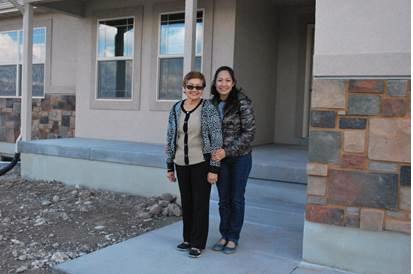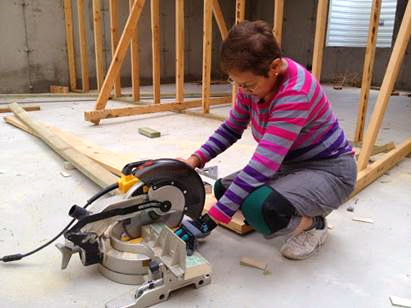Jane Farr was 64 years old when she and her husband decided to build their own home. They weren’t just designing the house and handing over plans to a contractor—they were going to be responsible for physical labor, including roofing, framing and more. Since their marriage a few years prior, the Farrs lived in a basement apartment and looked forward to one day being able to host family, especially when Farr’s children came to visit from the Phillippines.
They applied for and were approved to participate in Self-Help Homes, an organization that coordinates funding and resources to help five to 12 individuals or families at a time in helping to build each others’ homes. Farr and her husband would be responsible for at least 35 hours of work a week and she was a little worried about how they would complete it, “in their old age.” Her husband, Ron Farr, was confident that they could do it together with the help of volunteers, family and friends.
Three days before they were going to break ground on the project, Ron passed away, however, Farr moved forward.
“I was blessed with kind and supportive supervisors and four other families who were understanding of my limitations,” Farr said, less than a year later, during the open house for the four completed homes. “There were many times I felt protected during the program. I felt Ron was there for me. With my success in the Rural Housing Develop Corporation Mutual Self-Help Homes program, I could say to all that it is never too late to dream!”
Bishop credits Self-Help Homes’ success in Utah to a commitment to building good, long-term homes that elevate the neighborhoods where they build. They use current plans and update them to make sure the style of the homes will fit in and be an enhancement to the neighborhood.
In fact, an estimated 42 percent of Utah County would qualify for a program like this, according to Self-Help Homes.
Bank of American Fork, a WIB member, assists in programs like these by helping to obtain Affordable Housing Program (AHP) grant funds—for Self-Help Homes the grant funds are used to buy lots for upcoming neighborhood builds. The bank also donates time, tools and other equipment.
Self-Help Homes isn’t the only program benefiting from AHP grant funds. Bank of American Fork has helped other organizations like Northern Utah Neighborhood Improvement Project and Springville Senior Housing to obtain grant funds and has participated in programs like the Federal Home Loan Bank of Seattle’s Homestart for more than a decade. Homestart provides grants to qualified home buyers to assist them with their down payment or closing costs.
All of these programs and organizations work in different ways to help individuals and families, but one thing is the same—people are helping their friends, family and neighbors.
Bill Swadley, a vice president and business development officer at Bank of American Fork, originally became involved in community reinvestment almost three decades ago. Along with others at the bank, most of his job is spent finding groups like Self-Help Homes, Habitat for Humanity, Homestart and more for the bank to help support.
“These programs give people chances they may not have had otherwise. It allows more people to enter the free market system through home ownership or through starting a business. Individuals, families and our communities are strengthened,” Swadley said. “Bottom line, for me—it’s just the right thing to do.”
Swadley is just one of the many people at Bank of American Fork who are passionate about community reinvestment. Bill Swadley, Gary Sell, Richard Gray and Kelly Palmer are all involved in projects like Self-Help Homes. Their involvement includes a wide breadth of projects that help many segments of the communities the bank serves, including seniors, migrant workers, single-parent families, persons overcoming addiction, special-needs families and more.
“We exist to strengthen our communities,” said Swadley. “We live and work here, too, so we have a vested interest in seeing our neighbors, friends with small businesses and the economy thrive.”
More than 415 individuals or families are in homes partially funded by AHP grants that Bank of American Fork helped obtain. Another 63 are currently underway.
“There’s this electricity at the open houses,” said Gary Sell, vice president and mortgage loan officer at Bank of American Fork. “I love going because I get to hear two or three individuals talk about their experience. The whole neighborhood is made up of people who worked together to build their homes so there’s this energy between them.”
Bank of American Fork’s involvement in community reinvestment goes beyond community development loans for organizations like Self-Help Homes to help build houses. Bank of American Fork also makes more low-to-moderate-income mortgage loans than many of its peer banks. In making loans to small business owners, Bank of American Fork has helped create many jobs in our communities.
In 2014 Bank of American Fork was one of only 41 banks in the country that received an “outstanding” rating for community reinvestment from the Federal Deposit Insurance Corporation. The examination included a thorough look at the bank’s involvement in community-development lending compared to peer banks, low-to-moderate income loans compared to peer banks, the amount of community-development contributions to qualified organizations and the number and volume of employee hours spent serving in community-development organizations.
These programs work because of the people. People are behind all of the mechanisms that are building our communities, piece by piece. The people building their own homes, who, like Jan Farr, might come in a little unsure of their abilities, but come out very able and confident. People like Brad Bishop and Karen Weatherspoon at Self-Help Homes who run the program, find potential homeowners and show them they can build a safe and beautiful home. And then there are people like Bill Swadley, Gary Sell and others at Bank of American Fork who are passionate about reinvesting in the community.
With so many people who want to see Utah’s communities grow and the people prosper, Jane Farr was right when she said, “With courage, persistence and determination, you can win.”





